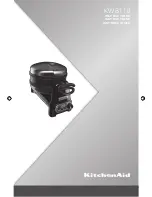
de
Ø
Montageanleitung
Anschluss
Das Gerät ist steckerfertig und darf nur an eine vorschriftsmäßig
installierte Schutzkontakt-Steckdose angeschlossen werden.
Das Verlegen einer Steckdose oder Austausch der Anschluss-
leitung darf nur vom Elektrofachmann unter Berücksichtigung
der einschlägigen Vorschriften ausgeführt werden.
Wenn der Stecker nach dem Einbau nicht mehr erreichbar ist,
muss installationsseitig eine allpolige Trennvorrichtung mit
einem Kontaktabstand von min. 3 mm vorhanden sein.
Nur ein fachgerechter Einbau nach dieser Montageanleitung
garantiert einen sicheren Gebrauch. Bei Schäden durch fal-
schen Einbau haftet der Monteur.
Nicht befestigte Möbel mit einem handelsüblichen Winkel an der
Wand befestigen.
Lieferumfang
Einbau des Gerätes
Neben dem Einbaumöbel ist ein Abstand von mindestens
200 mm zur Wand einzuhalten.
Für ausreichende Durchlüftung sorgen. Dazu die Möbelrück-
wand entfernen oder eine Öffnung von 500 x 400 mm aus-
schneiden.
Zwischen Wand und Schrankboden bzw. Rückwand des darü-
berliegenden Schrankes muss ein Abstand von mind. 45 mm
eingehalten werden. Die Lüftungsschlitze und Ansaugöffnungen
dürfen nicht verdeckt werden.
Um eine barrierefreie Bedienbarkeit sicherzustellen, insbeson-
dere in Kombination mit anderen Einbaugeräten, sollte eine Ein-
bauhöhe von 120 cm nicht überschritten werden.
Werden Einbaugeräte übereinander montiert, so ist der
Espresso-Vollautomat aufgrund der Bedienung immer als unte-
res Gerät und nie oben einzubauen. Ausnahme ist der Einbau
über einer Wärmeschublade, hier ist eine Nischenhöhe von
590 mm erforderlich. Hierzu auch die Montageanleitung des
darüber liegenden Gerätes oder der Wärmeschublade beach-
ten.
Wird das Gerät direkt unter einer Arbeitsplatte eingebaut, ist dar-
auf zu achten, dass ein Lüftungsschlitz von mind. 200 cm² vor-
handen ist.
Die ideale Einbauhöhe für den Espresso-Vollautomaten, gemes-
sen vom Fußboden bis Unterkante Gerät, beträgt 950 mm.
1.
Zuerst alle Teile nach Anleitung auspacken und auf Transport-
schäden überprüfen. Beschädigte Geräte dürfen nicht in Be-
trieb genommen werden.
2.
Die Einbaumaße je nach Einbauvariante berücksichtigen.
3.
Das Chassis
a
in das Einbaumöbel einsetzen.
4.
Das eingesetzte Chassis
a
mit der Wasserwaage kontrollieren.
Die Anschlussleitung in die Steckdose einstecken. Sie darf
nicht eingeklemmt werden.
5.
Das Chassis
a
mittig und vorne bündig mit den beiliegenden
4 Schrauben
c
befestigen.
6.
Die Feder
e
aus der Transportsicherung entnehmen und zur
Federhalterung
f
führen, um das Auszugssystem zu aktivieren.
7.
Beide Teleskopauszüge ganz herausziehen.
8.
Die Trägerplatte
b
mit dem Gerät auf die beiden Teleskopaus-
züge aufsetzen.
Hinweis:
Das Gerät nur auf die komplett herausgezogenen Te-
leskopauszüge aufsetzen, damit nach dem Einschieben die
Ausfuhrautomatik aktiviert wird.
9.
Beide Teleskopauszüge kontrollieren. Sie müssen sich ganz
vorne befinden, das Gerät muss hinten eingehakt sein.
10.
Die Teleskopauszüge und das Gerät mit den beiden Schrau-
ben
d
fixieren.
11.
Das Spiralkabel des Gerätes am Chassis einstecken, nicht
überdehnen. Das Gerät hineinschieben.
12.
Anschließend die einwandfreie Funktion der Auszugsmecha-
nik überprüfen.
13.
Steht das Gerät vor oder rastet nach dem Einschieben nicht
ein, kann es justiert werden.
– Das Gerät steht vor:
Inbus SW3 einsetzen und nach links
X
drehen.
– Das Gerät rastet nicht ein:
Inbus Inbus SW3 einsetzen und nach rechts
Y
drehen.
en
Ú
Installation instructions
Connection
The appliance is ready to be plugged in and must only be
connected to a protective contact socket that has been installed
according to the regulations. Only a qualified electrician who
takes the appropriate regulations into account may install a
socket or replace the connecting cable.
If the plug is no longer accessible following installation, an all-
pole disconnection switch must be present on the installation
side with a contact gap of at least 3 mm.
Safe use of this appliance can only be guaranteed if it has been
installed professionally in accordance with these installation
instructions. The installer is liable for damages incurred as a
result of incorrect installation.
Secure freestanding units to the wall using standard,
commercially available brackets.
Included in delivery
Installing the appliance
The distance between the built-in unit and the wall must be at
least 200 mm.
Ensure sufficient ventilation. To do this, remove the furniture
back panel or cut out an opening measuring 500 x 400 mm.
The distance between the wall and the floor of the cupboard or
the back wall of the cupboard above must be at least 45 mm.
The ventilation slots and the air intake openings must not be
covered.
To ensure problem-free operation, particularly in combination
with other built-in appliances, the built-in height should not
exceed 120 cm.
If built-in appliances are vertically stacked, the fully automatic
espresso machine must always be installed at the bottom and
never at the top due to its operation. The only exception is if the
appliance is to be installed above a warming drawer, where a
niche height of 590 mm is required. To do this, also follow the
installation instructions for the appliance which is above the
espresso machine or for the warming drawer.
If the appliance is installed directly below a worktop, it is
important to ensure that there is a ventilation slot of at least
200 cm².
The ideal installation height for the fully automatic espresso
machine, measured from the floor to the lower edge of the
appliance, is 950 mm.
1.
First unpack all components in accordance with the
instructions and then check them for transport damage.
Damaged appliances must not be put into operation.
2.
Take note of the installation dimensions of the particular model.
3.
Insert the chassis
a
into the built-in unit.
4.
Check the inserted chassis
a
with a spirit level. Plug the
connecting cable into the socket. It must not become trapped.
5.
Attach the chassis
a
centred and flush at the front using the
4 screws provided
c
.
6.
Remove the spring
e
from the transit supports, guiding it to the
spring holder
f
in order to activate the pull-out system.
7.
Pull out the two telescopic pull-out racks fully.
8.
Place the support plate
b
with the appliance on the two
telescopic pull-out racks.
Note:
The appliance must be placed on the telescopic pull-out
racks only when they are fully extended, so that the deployment
mechanism is activated when it is pushed in.
a
Chassis (mit Teleskopauszügen)
b
Trägerplatte mit Gerät und Front
c
Holzschrauben (4 Stück)
d
selbstschneidende Schrauben
(2 Stück)
a
Chassis (with telescopic pull-out
racks)
b
Support plate with appliance and
front panel
c
Wood screws (x 4)
d
Self-tapping screws (x 2)
Содержание CM 450
Страница 2: ...PLQ PP PP PP PP PP PP PP PP PP PP PLQ PP PP PP PP PLQ PP PLQ PP PLQ F...
Страница 3: ......
Страница 4: ...E...
Страница 5: ......
Страница 6: ......
Страница 19: ...6 e f 7 8 b 9 10 d 11 12 13 SW3 X SW3 Y kk DNr 1 2 3 B 4 B 5 B D 6 F G 7 8 C 9 10 E 11 12 13 48 9 48 9 a b d...
Страница 24: ......








































